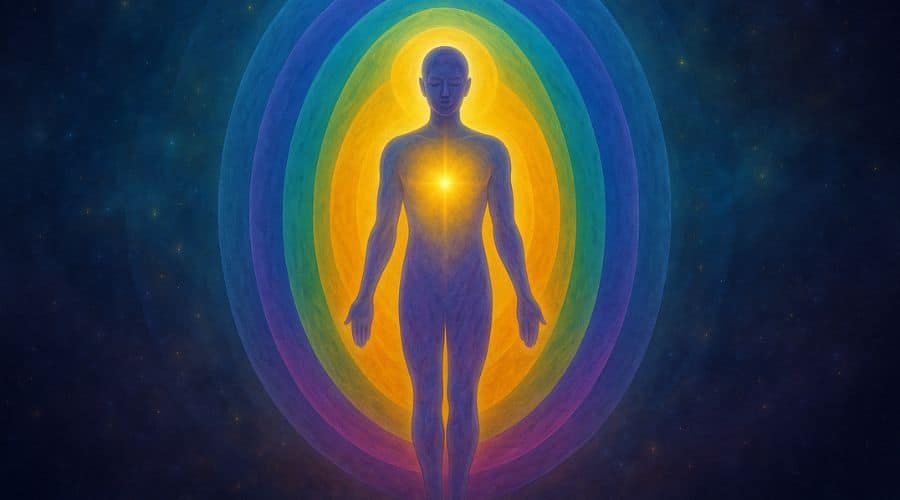A Practical Guide to Your Energy Field: Understanding the 7 Layers of Your Aura

We’ve all had that experience: you enter a room and get an immediate impression—a sense of tension, joy, or unease—before anyone even says a word. Or met a complete stranger and felt an instant sense of ease and comfort? That experience isn’t just your imagination; it’s your innate ability to sense the personal energy field that surrounds every one of us.
Think of this field as your personal atmosphere. Just like the Earth’s atmosphere, it has different layers, each with a unique climate and function. It can be calm and clear one day, or turbulent and stormy the next, influencing your mood, your health, and how you interact with the world around you.
Learning about this energy field isn’t about developing a mystical power. It’s a practical tool for profound self-awareness. By understanding its layers, you can better diagnose what’s going on inside you and learn how to consciously cultivate a state of balance and well-being. Let’s walk through this inner landscape together.
The Seven Layers, Demystified
Your energy field, or aura, is composed of seven primary layers that interpenetrate each other and your physical body. Each one corresponds to a different aspect of your human experience.
1. The Etheric Layer (The Physical Blueprint)
This is the innermost layer, extending just a couple of inches from your body. It’s essentially the energy blueprint of your physical self.
- Core Function: It’s directly tied to your physical vitality, bodily sensations, and overall health. When your physical self is in a state of good health and strength, this layer mirrors that with vibrancy and resilience.
- Relatable Example: A balanced Etheric layer feels like physical energy and resilience; you wake up feeling rested and have the stamina to get through your day. An imbalanced or depleted layer manifests as chronic fatigue, feeling physically “off” for no clear reason, or having a low tolerance for physical stress.
- Connection to Well-being: Nurturing this layer is fundamentally about nurturing your physical body. Good nutrition, adequate sleep, and healthy movement are the best ways to keep it strong.
2. The Emotional Layer (Your Inner Weather)
Extending a few inches beyond the Etheric, this layer is a fluid, dynamic space that houses your feelings and emotions. It’s your inner weather system.
- Core Function: This is where your emotions are processed. It changes constantly depending on your mood, from bright and calm when you’re happy to dark and turbulent when you’re upset.
- Relatable Example: When this layer is balanced, you can feel your emotions, process them, and let them go without getting stuck. You have a sense of emotional stability. When it’s imbalanced, you might experience intense mood swings, feel overwhelmed by your feelings, or carry around unprocessed emotional baggage that clouds your daily experience.
- Connection to Well-being: A healthy emotional layer is key to emotional intelligence. It allows you to respond to situations thoughtfully rather than reactively.
3. The Mental Layer (The Mind’s Workspace)
This third layer holds your thoughts, ideas, logic, and core beliefs. It’s the structured workspace where your mindset is formed.
- Core Function: It governs your thought processes and mental constructs. It’s typically brighter and more structured when your thinking is clear and organized.
- Relatable Example: A balanced mental layer feels like clear focus, mental flexibility, and the ability to entertain new ideas. You can tackle problems skillfully and cultivate a beneficial way of thinking. An imbalanced state can feel like mental fog, analysis paralysis, rigid thinking, or getting stuck in negative thought loops.
- Connection to Well-being: Clarity in this layer is the foundation for effective decision-making, learning, and cultivating a positive outlook.
4. The Astral Layer (The Relational Bridge)
Located in the middle of the auric field, this layer is all about connection. It acts as the conduit linking your inner world to the bonds you form with those around you.
- Core Function: This is the field of interpersonal dynamics—love, connection, and the energetic cords we form with family, friends, and partners.
- Relatable Example: When your Astral layer is healthy, you form loving, balanced relationships with clear boundaries. You feel connected to others without losing your sense of self. An imbalance can lead to codependency, fear of intimacy, unhealthy attachments, or a profound feeling of isolation.
- Connection to Well-being: The health of this layer dictates the health of your social life and your ability to give and receive love freely.
5. The Etheric Template (Your Life’s Blueprint)
Here lies the essential framework for your unique life path and individual identity. It’s where your authentic self is defined, separate from the expectations of others.
- Core Function: It contains the template for your purpose and the path you are meant to walk in this life. It’s the energetic foundation of your personal truth.
- Relatable Example: A connection to this layer brings a powerful feeling of purpose and a solid sense of self. The choices you make are a true expression of your inner values. An imbalance here can feel like being lost, lacking direction, living a life that doesn’t feel like your own, or constantly seeking external validation.
- Connection to Well-being: A strong connection to this layer provides the inner compass that guides you toward a fulfilling and authentic life.
6. The Celestial Layer (Connection and Inspiration)
This sixth layer connects you to a broader sense of awareness and inspiration. It’s where you experience feelings that seem to come from beyond your everyday mind.
- Core Function: This is the level of higher consciousness, intuition, and inspiration. It’s the feeling of awe you get from watching a beautiful sunset or the unconditional love you feel for a child.
- Relatable Example: A balanced Celestial layer brings feelings of inspiration, creativity, and a deep connection to humanity and the world around you. You experience a sense of belonging to a greater whole. An imbalance can lead to cynicism, a lack of inspiration, or feeling disconnected from the beauty and wonder of life.
- Connection to Well-being: This layer fuels your creativity, intuition, and your capacity to experience joy and wonder.
7. The Ketheric/Causal Layer (The Protective Boundary)
The outermost layer is a strong, protective boundary that holds your entire energy system together. It integrates all the other layers into a cohesive whole.
- Core Function: This layer acts as a protective shell and connects your personal energy field to the wider world. It reflects your holistic integration and your core understanding of life.
- Relatable Example: When this layer is strong, you feel resilient, secure in yourself, and able to navigate the world without feeling constantly vulnerable to external energies. An imbalance might feel like energetic sensitivity, a sense of being ungrounded, or a persistent feeling of being disconnected from the flow of life.
- Connection to Well-being: This layer is fundamental to your sense of security, resilience, and your ability to feel whole and integrated.
Simple Tools for Energetic Maintenance
Just like physical hygiene, “energetic hygiene” involves simple, regular practices to keep your personal atmosphere clear and resilient.
- Spend Time in Nature: The earth has a natural, grounding frequency. Simply walking barefoot on grass, sitting by a tree, or listening to the ocean waves can help reset your energy field, release stress, and restore your sense of balance.
- Practice Mindful Breathing: When you feel scattered or overwhelmed, your breath is your anchor. Try the “box breathing” method: take a slow breath in for four counts, hold it for four counts, release it for four counts, and wait for four counts before the next breath. Repeat this for a few minutes. This easy exercise helps to settle your nervous system and ground your awareness in the present.
- Journal for Clarity: Your thoughts and feelings can get tangled. Externalizing them onto paper is a powerful way to bring clarity to your mental and emotional layers. You might pose questions to yourself such as, “What emotion is most present for me right now?” or “What thought is looping in my mind?” You don’t need answers; just the act of asking and writing creates space.
Conclusion: Your Path to Self-Awareness
Ultimately, understanding the layers of your aura isn’t about seeing brilliant colors or performing magic. It’s a deeply practical framework for self-knowledge. It gives you a new language to understand why you feel the way you do and empowers you to take an active role in your own well-being.
By learning to tend to your personal energy—through rest, healthy emotions, clear thinking, and strong boundaries—you are simply learning to care for all parts of yourself. This awareness is the first step toward building greater emotional resilience, fostering healthier relationships, and creating a life that feels balanced, authentic, and truly your own.




